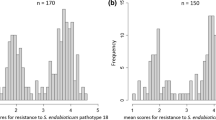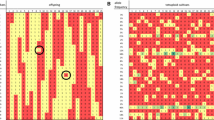Abstract
Verticillium wilt disease of potato is caused predominantly by Verticillium albo-atrum and V. dahliae. StVe1 —a putative QTL for resistance against V. dahliae —was previously mapped to potato chromosome 9. To develop allele-specific, SNP-based markers within the locus, the StVe1 fragment from a set of 30 North American potato cultivars was analyzed. Three distinct and highly diverse haplotypes can be distinguished at the StVe1 locus. These were detected in 97%, 33%, and 10% of the cultivars analyzed. We tested for haplotype association and for genetic linkage between the StVe1 haplotypes and resistance of tetraploid potato to V. albo-atrum. Moreover, field resistance was assessed in diploid populations with known molecular linkage maps in order to identify novel QTLs. Resistance QTLs against V. albo-atrum were detected on four chromosomes (2, 6, 9, and 12) at the diploid level, with one QTL on chromosome 2 contributing over 40% to the total phenotypic variation of the trait. At the tetraploid level, a significant association between the StVe1-839-C haplotype and susceptibility to the disease was detected, suggesting that resistance-related genes directed against V. albo-atrum and V. dahliae are located in the same genomic region of chromosome 9. However, on the basis of the present analysis, we cannot determine whether these genes are closely linked or if a single gene provides resistance against both Verticillium species. To assess the usefulness of the StVe1-839-C haplotype for marker-assisted selection, we subjected the resistance data to Bayesian analysis, and calculated positive (0.65) and negative (0.75) predictive values, and overall predictive accuracy (0.72). Our results indicate that tagging of additional genes for resistance to Verticillium with molecular markers will be required for efficient marker-assisted selection.






Similar content being viewed by others
References
Akey J, Jin L, Xiong MM (2001) Haplotypes vs single marker linkage disequilibrium tests: what do we gain? Eur J Hum Genet 9:291–300
Ausher R, Katan J, Ovadia S (1975) An improved selective medium for the isolation of Verticillium dahliae. Phytoparasitica 3:133–137
Bonierbale MW, Plaisted RL, Pineda O, Tanksley SD (1994) QTL analysis of trichome-mediated insect resistance in potato. Theor Appl Genet 87:973–987
Chai YR, Zhao LX, Liao ZH, Sun XF, Zuo KJ, Zhang L, Wang SG, Tang KX (2003) Molecular cloning of a potential Verticillium dahliae resistance gene SlVe1 with multi-site polyadenylation from Solanum lycopersicoides. DNA Sequence 14:375–384
Concibido VC, Secor GA, Jansky SH (1994) Evaluation of resistance to Verticillium wilt in diploid, wild potato interspecific hybrids. Euphytica 76:145–152
Costanzo S (2003) Characterization and mapping of QTLs conferring resistance to late blight in potato. PhD thesis, Department of Plant Pathology, Pennsylvania State University, University Park, pp 138
Diwan N, Fluhr R, Eshed Y, Zamir D, Tanksley SD (1999) Mapping of Ve in tomato: a gene conferring resistance to the broad-spectrum pathogen, Verticillium dahliae race 1. Theor Appl Genet 98:315–319
Flint-Garcia SA, Thornsberry JM, Buckler ES (2003) Structure of linkage disequilibrium in plants. Annu Rev Plant Biol 54:357–374
Gabriel SB, et al (2002) The structure of haplotype blocks in the human genome. Science 296:2225–2229
Gebhardt C, Ballvora A, Walkemeier B, Oberhagemann P, Schüler K (2004) Assessing genetic potential in germ plasm collections of crop plants by marker-trait association: a case study for potatoes with quantitative variation of resistance to late blight and maturity type. Mol Breeding 13:93–102
Goth RW, Haynes KG, Wilson DR (1993) Relationship of Verticillium wilt with Pink-eye of potato in Maine. Plant Dis 77:402–405
Hall TA (1999) BioEdit: a user-friendly biological sequence alignment editor and analysis program for Windows 95/98/NT. Nucleic Acids Symp Ser 41:95–98
Hunter DE, Darling HM, Stevenson FJ, Cunningham CE (1968) Inheritance of resistance to Verticillium wilt in Wisconsin. Amer Potato J 45:72–78
Jansky S (2000) Breeding for disease resistance in potato. Plant Breed Rev 19:69–155
Jansky SH, Rouse DI (2000) Identification of potato interspecific hybrids resistant to Verticillium wilt and determination of criteria for resistance assessment. Potato Res 43:239–251
Jansky SH, Rouse DI (2003) Multiple disease resistance in interspecific hybrids of potato. Plant Dis 87:266–272
Kawchuk LM, Hachey J, Lynch DR, Kulcsar F, van Rooijen G, Waterer DR, Robertson A, Kokko E, Byers R, Howard RJ, Fischer R, Prufer D (2001) Tomato Ve disease resistance genes encode cell surface-like receptors. Proc Natl Acad Sci USA 98:6511–6515
Kumar S, Tamura K, Jakobsen IB, Nei M (2001) MEGA2: molecular evolutionary genetics analysis software. Bioinformatics 17:1244–1245
Love SL (1999) Founding clones, major contributing ancestors, and exotic progenitors of prominent North American potato cultivars. Am J Potato Res 76:263–272
Lynch DR, Kawchuk LM, Hachey J, Bains PS, Howard RJ (1997) Identification of a gene conferring high levels of resistance to Verticillium wilt in Solanum chacoense. Plant Dis 81:1011–1014
Marth GT, Korf I, Yandell MD, Yeh RT, Gu ZJ, Zakeri H, Stitziel NO, Hillier L, Kwok PY, Gish WR (1999) A general approach to single-nucleotide polymorphism discovery. Nature Genet 23:452–456
Nachmias A, Caligari PDS, Brown J (1990) Measurement of field-resistance of potatoes to Verticillium wilt ( Verticillium dahliae). Potato Res 33:201–209
Nazar RN, Hu X, Schmidt J, Culham D, Robb J (1991) Potential use of PCR-amplified ribosomal intergenetic sequences in the detection and differentiation of verticillium wilt pathogens. Physiol Mol Plant P 39:1–11
Pritchard JK, Stephens M, Donnelly P (2000) Inference of population structure using multilocus genotype data. Genetics 155:945–959
Rickert AM, Premstaller A, Gebhardt C, Oefner PJ (2002) Genotyping of SNPs in a polyploid genome by PyrosequencingTM. Biotechniques 32:592–603
Rickert AM, Kim JH, Meyer S, Nagel A, Ballvora A, Oefner PJ, Gebhardt C (2003) First-generation SNP/InDel markers tagging loci for pathogen resistance in the potato genome. Plant Biotechnol J 1:399–410
Rozas J, Rozas R (1999) DnaSP version 3: an integrated program for molecular population genetics and molecular evolution analysis. Bioinformatics 15:174–175
Simko I (2002) Comparative analysis of quantitative trait loci for foliage resistance to Phytophthora infestans in tuber-bearing Solanum species. Am J Potato Res 79:125–132
Simko I, Costanzo S, Haynes KG, Christ BJ, Jones RW (2004a) Linkage disequilibrium mapping of a Verticillium dahliae resistance quantitative trait locus in tetraploid potato ( Solanum tuberosum) through a candidate gene approach. Theor Appl Genet 108:217–224
Simko I, Haynes KG, Jones RW (2004b) Mining data from potato pedigrees: tracking the origin of susceptibility and resistance to Verticillium dahliae in North American cultivars through molecular marker analysis. Theor Appl Genet 108:225–230
Thompson JD, Gibson TJ, Plewniak F, Jeanmougin F, Higgins DG (1997) The CLUSTAL X windows interface: flexible strategies for multiple sequence alignment aided by quality analysis tools. Nucleic Acids Res 25:4876–4882
Van Ooijen JW, Boer MP, Jansen RC, Maliepaard C (2000) MapQTL version 4.0: software for the calculation of QTL positions on genetic maps. 4.0. Plant Research International, Wageningen
Acknowledgements
We would like to thank Dr. N. Anderson, Dr. J. Bradeen, and Dr. A. Grybauskas for providing Verticillium albo-atrum cultures, Dr. R. Veilleux for monoploid potato genotypes, Dr. S. Jansky and Dr. D. Fravel for sharing their expertise in Verticillium cultivation and identification, D. Hyten for help with data analysis, Dr. M. Ospina-Giraldo for valuable discussion, and Dr. J. Bradeen and Dr. W. De Jong for critically reading the manuscript. This project was supported in part by the ARS potato research program.
Author information
Authors and Affiliations
Corresponding author
Additional information
Communicated by M.-A. Grandbastien
Rights and permissions
About this article
Cite this article
Simko, I., Haynes, K.G., Ewing, E.E. et al. Mapping genes for resistance to Verticillium albo-atrum in tetraploid and diploid potato populations using haplotype association tests and genetic linkage analysis. Mol Genet Genomics 271, 522–531 (2004). https://doi.org/10.1007/s00438-004-1010-z
Received:
Accepted:
Published:
Issue Date:
DOI: https://doi.org/10.1007/s00438-004-1010-z




